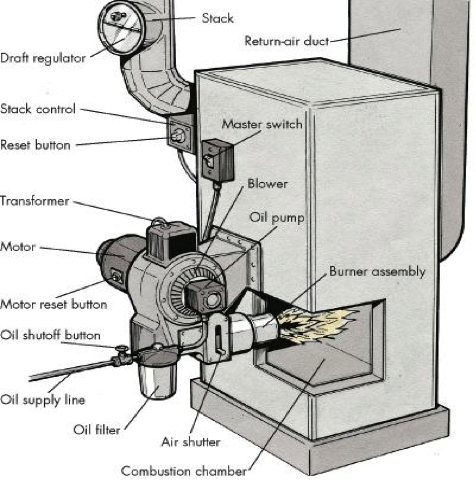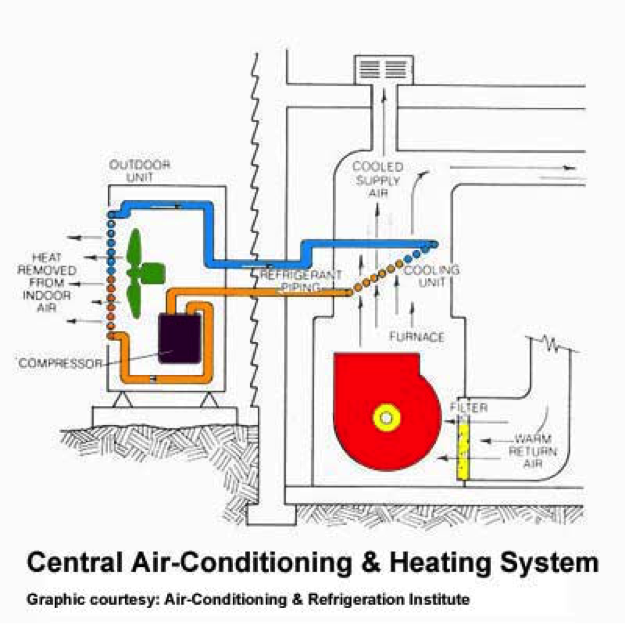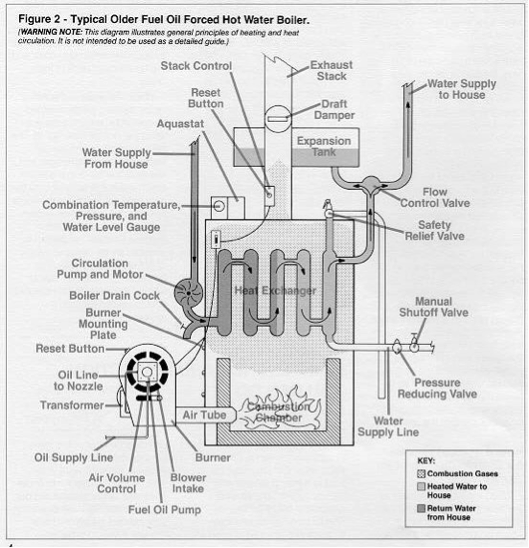How Does My HVAC System Work?
Have you ever wondered how your HVAC (Heating, Ventilation, and Air Conditioning) system keeps your home comfortable year-round? Your HVAC system is a complex network of components that work together seamlessly to provide heating, cooling, and proper ventilation. In this comprehensive guide, we’ll take a closer look at how your HVAC system works, from the moment you adjust the thermostat to the comfortable air that fills your home.
Understanding the Basics
Before we dive into the inner workings of your HVAC system, it’s essential to understand the basic components:
- Thermostat: The control center of your HVAC system. You set the desired temperature here.
- Furnace (for heating) or Air Conditioner (for cooling): The source of warm or cool air, respectively.
- Ductwork: A network of pipes or channels that distribute conditioned air throughout your home.
- Vents and Registers: These openings allow air to enter and exit rooms.
- Air Filter: Cleans the air of dust, debris, and allergens.
- Return Air Registers: Draws in the air from your home to be conditioned.
Let’s explore how these components work together to maintain a comfortable indoor environment.
Heating Process
- Thermostat Control: You set your thermostat to your desired temperature for heating. When the temperature falls below this point, it signals the system to start heating.
- Furnace Activation: The furnace ignites if you have a forced-air heating system. For other types of heating, like radiant heating, this step differs.
- Air Circulation: Once activated, the furnace or heating element warms the air, circulating through the ductwork by a blower fan.
- Distribution: The heated air flows through the ducts and out of the vents, filling your rooms with warm air.
- Thermostat Monitoring: The thermostat continually monitors the temperature, and when it reaches the set point, it signals the furnace to stop heating.
Cooling Process
- Thermostat Control: Set your thermostat to the desired temperature for cooling. When the indoor temperature rises above this point, it triggers the cooling process.
- Air Conditioning Activation: The air conditioner, typically located outside your home, starts running. It uses a refrigeration cycle to remove heat from the indoor air.
- Cool Air Generation: Warm air inside your home is drawn in through the return air registers. This air passes over evaporator coils filled with refrigerant, cooling it down.
- Air Circulation: A blower fan then circulates the now-cooled air through the ductwork and into your rooms.
- Thermostat Monitoring: The thermostat continues to monitor the temperature. Once it reaches the set point, it signals the air conditioner to stop cooling.
Ventilation and Air Quality
In addition to heating and cooling, your HVAC system plays a crucial role in maintaining indoor air quality and proper ventilation. The air filter in your system traps dust, allergens, and contaminants, ensuring the air you breathe is clean and healthy. Proper ventilation brings in fresh outdoor air, reducing indoor pollutants and maintaining a comfortable environment.
Your HVAC system is a marvel of modern engineering, providing year-round comfort and air quality. Understanding how it works allows you to make the most of this essential home system. Regular maintenance and professional servicing ensure it continues to function efficiently, keeping your home comfortable and your indoor air clean. The next time you adjust your thermostat, you’ll have a deeper appreciation for the intricate workings of your HVAC system.
Types of Fuel
Heating Oil/ Diesel / Kerosene – Petroleum-based fuels became popular for home heating in 1920 (with the thermostat’s invention). According to the American Petroleum Institute, new oil heating systems boast energy efficiency ratings ranging from 83 to 94 percent. Over 8.5 million American households, mainly in the Northeastern states, rely on heating oil to keep warm in winter. Heating oil is typically stored in a steel tank somewhere in the home. Tanks can be located above ground, in the basement, or on the ground. A typical house tank is 275 gallons.
Natural Gas – Natural gas might be considered an uninteresting gas – it is colorless, shapeless, and odorless in its pure form. Quite uninteresting – except that natural gas is flammable and abundant in the United States. When burned, it gives off much energy with fewer emissions than other sources. In the 1960s, the construction of thousands of miles of pipelines in America provided the foundation for natural gas transportation. New uses for natural gas were discovered; these included using natural gas to heat homes and operate appliances such as water heaters, ovens, and cooktops. Natural gas runs from the main into a home in a service line. When the gas passes through a customer’s gas meter, it becomes the customer’s property.
Propane/LPG – Propane is a hydrocarbon, sometimes called liquefied petroleum gas, LP-gas, or LPG. Propane is produced from natural gas processing and crude oil refining in roughly equal amounts from each source. Nearly 97 percent of propane consumed in the United States is produced in North America. It is nontoxic, colorless, and virtually odorless. Large tanks can be buried underground to fuel homes because propane is a nontoxic, nonpoisonous fuel that doesn’t contaminate aquifers or soil. Refueling a propane vehicle takes about the same time as refueling a gasoline vehicle. And propane is the only alternative fuel with fueling stations in every state.
Forced Air System
This system is by far the most common type of home heating and cooling system. An appliance fired by gas, oil, or wood in which air is heated to be circulated throughout a building in a heating system. Air is distributed from the furnace through ductwork and into the room by registers.
Fuel Sources – Natural Gas, Propane, Oil or Electricity

Advantages
- A Duct system can also be used for cooling
- Air may be filtered to improve air quality
- The furnace can attain the highest AFUE (efficiency) than boiler systems
Disadvantages
- Fan or blower can often be heard when running
- Moving air can distribute allergens.
- It can be considered drafty and have more temp fluctuation.
Hot Water Baseboard or Radiator System
A boiler is a heating plant that creates hot water or steam for hydronic baseboards, radiant heat, or steam radiator heating systems. Steam boilers are more complex than hot water boilers and have special gauge glass, pressure gauges, blow-off valves, and automatic feeds. Hot water is heated by the boiler and piped to “fin-tube” baseboard units or cast iron radiators mounted along walls. The fins in baseboards increase the surface area of heat dissipation, making the unit more efficient.
Air is distributed by convection as air rises and is heated by the baseboard or radiator unit.
Fuel Sources – Natural Gas, Propane, Oil, or Electricity may fuel the boiler.
Advantages
- Energy efficient
- Quiet
- Close temperature control creates a more constant, even heat
Disadvantages
- Baseboard radiation/convection units must remain unobstructed and can provide challenges in furniture placement and drape design.
- Slow temperature increase.
- Air conditioning requires a separate ductwork distribution and cooling system.
Steam Radiant Heating System
Steam radiators are nostalgic and not often used today. They are characterized by cast iron upright radiators radiating heat with steam. Steam systems come in two varieties: one-pipe and two-pipe systems. With one-pipe systems, the water and steam travel in the same pipe but in opposite directions. In two-pipe systems, steam flows in one pipe, and water condensate returns in another set of pipes. Heat is distributed with steam piping and radiator units.
Fuel Sources – Steam boilers may be fueled by natural gas, propane, oil, or electricity.
Advantages
- Efficient and warms spaces quickly
- Radiant heat is comfortable
- Old hot water system radiators can now be replaced with smaller convection units or vertical wall panel radiators.
Disadvantages
- Radiators can be unsightly
- Radiator locations may limit furniture placement and window coverings
- Air conditioning requires a separate ductwork distribution and cooling system.
Geothermal
The newest home heating (and cooling) technology is called a Geothermal Heat Pump (GHP). Heat pumps work like a refrigerator that can run in reverse. Heat is taken from one source and deposited in another location. With ground loop geothermal systems, heat is taken from or deposited to the earth using a ground loop pipe.
The EPA states that a Geothermal Heat Pump can save 30 to 70 percent on home heating and 20 to 50 percent on home cooling costs over conventional systems. But these systems are not cheap.
Air Conditioner
Air conditioners use chemicals (refrigerant or Freon) that easily convert from a gas to a liquid and back again. This chemical is used to remove heat from the inside of a home to the outside air. Air conditioners and refrigerators work the same way. Instead of cooling just the small, insulated space inside a refrigerator, an air conditioner cools a room, house, or business.

Heat Pump
A heat pump is an air conditioner with a valve that lets it switch between “air conditioner” and “heater.” When the valve is switched one way, the heat pump acts like an air conditioner, and when it is switched the other way, it reverses the flow of the liquid inside the heat pump and acts like a heater.
Air conditioners and heat pumps are designed for the size of the space needed. An accurate calculation will keep installation and operating costs down. If an AC is too small, it will not cool the space comfortably in extreme weather. Air conditioners that are too big use more electricity and leave the air in your house with excess humidity.
Ban on Production and Imports of Ozone-Depleting Refrigerants
In 1987, the Montreal Protocol, an international environmental agreement, established requirements that began the worldwide phase-out of ozone-depleting CFCs (chlorofluorocarbons). These requirements were later modified, leading to the phase-out in 1996 of CFC production in all developed nations. In 1992, the Montreal Protocol was amended to establish a schedule for the phase-out of HCFCs (hydrochlorofluorocarbons). HCFCs are less damaging to the ozone layer than CFCs but still contain ozone-destroying chlorine.
HCFC-22 (also known as R-22) has been the refrigerant for residential heat pumps and air-conditioning systems for over four decades. Unfortunately for the environment, releases of R-22, such as those from leaks, contribute to ozone depletion. In addition, R-22 is a greenhouse gas and the manufacture of R-22 results in a by-product (HFC-23) that contributes significantly to global warming. As the manufacture of R-22 is phased out over the coming years as part of the agreement to end the production of HCFCs, manufacturers of residential air conditioning systems are offering equipment that uses ozone-friendly refrigerants.
R-410A has replaced R-22 as the preferred refrigerant for use in residential and commercial air conditioners in Japan, Europe, and the United States
R-410A (which contains only fluorine) does not contribute to ozone depletion and is becoming more widely used as ozone-depleting refrigerants like R-22 are phased out. However, it has a high global warming potential (2088 times the effect of carbon dioxide), similar to R-22. Since R-410A allows for higher system efficiencies than an R-22 system by reducing power consumption, the overall impact on global warming of R-410A systems will be substantially lower than that of R-22 systems due to reduced greenhouse gas emissions from power plants.
Why You Can Trust Hillside
★ ★ ★ ★ ★
“We had an air conditioner tune up yesterday with amazing results! Thank you for your excellent service. We are highly impressed!”
– RACHEL
Verified Facebook Reviews
The Hillside Maintenance Plans
Keeping Your Paws Comfy All Year Round
The Hillside Maintenance Plans are designed to prevent minor problems from turning into major issues! Extend the life of your equipment, reduce the need for costly repairs, and increase the performance of your heating and cooling systems while lowering your utility bills.




